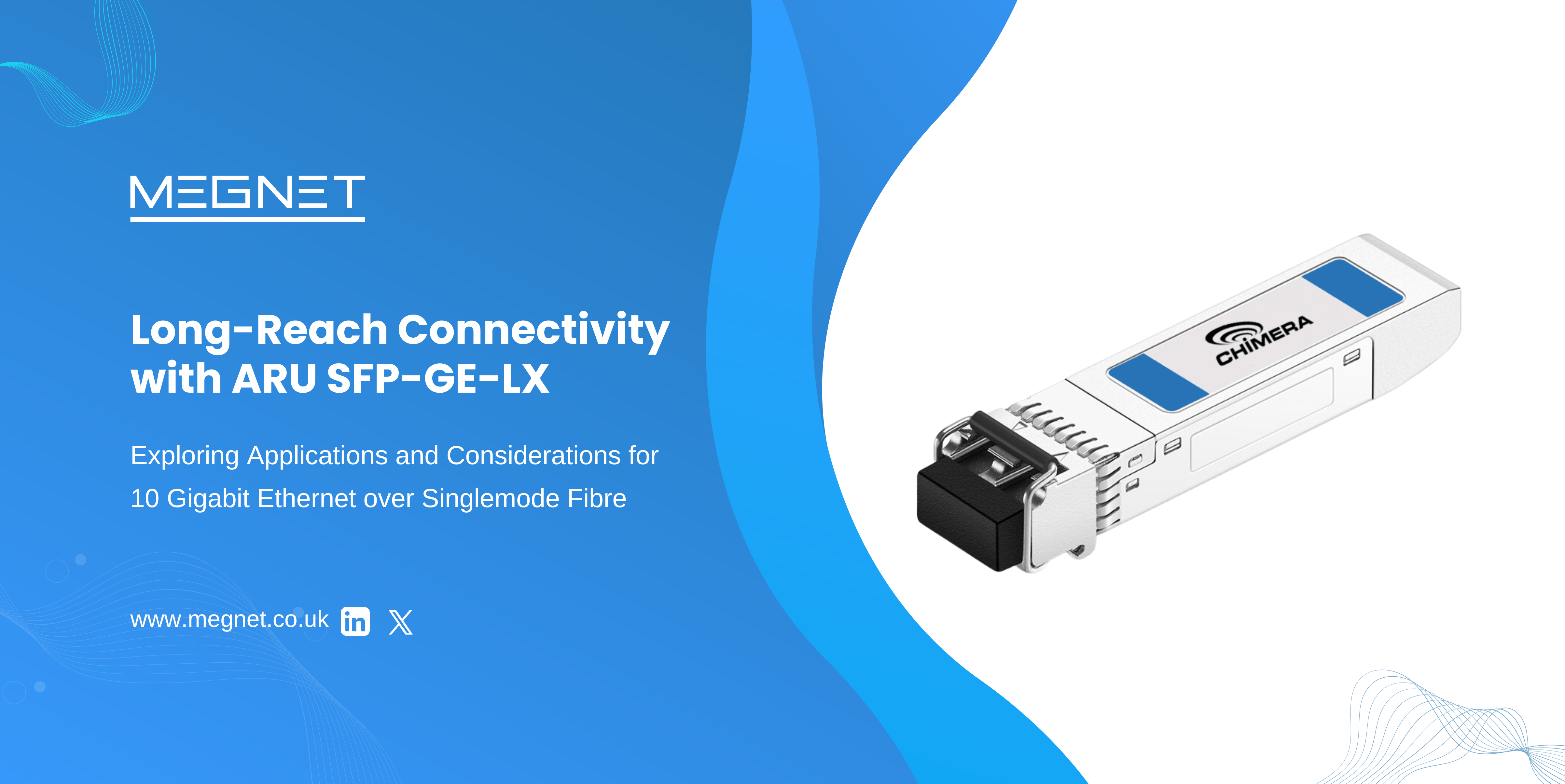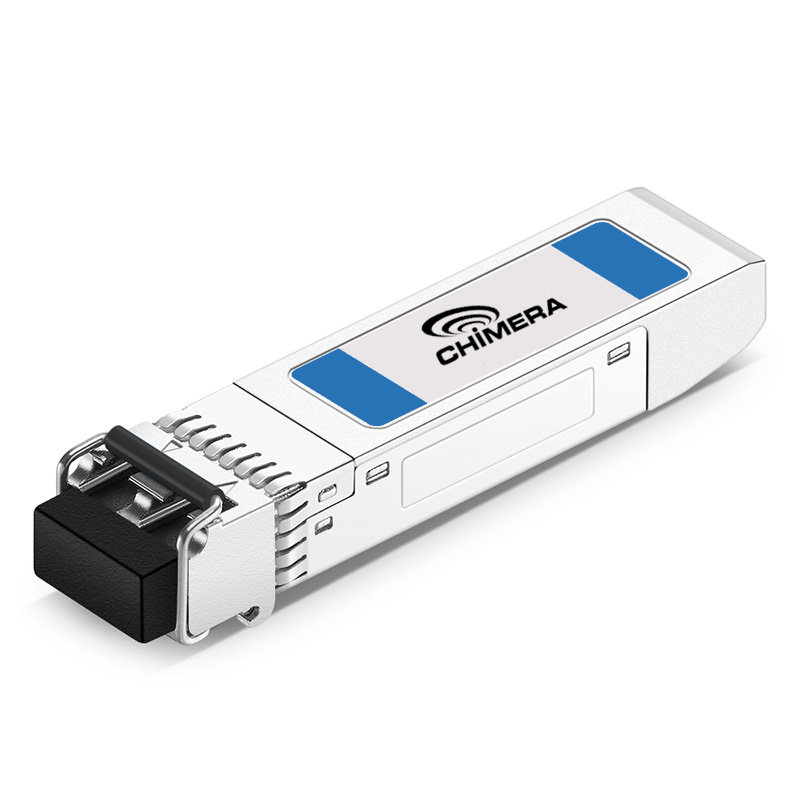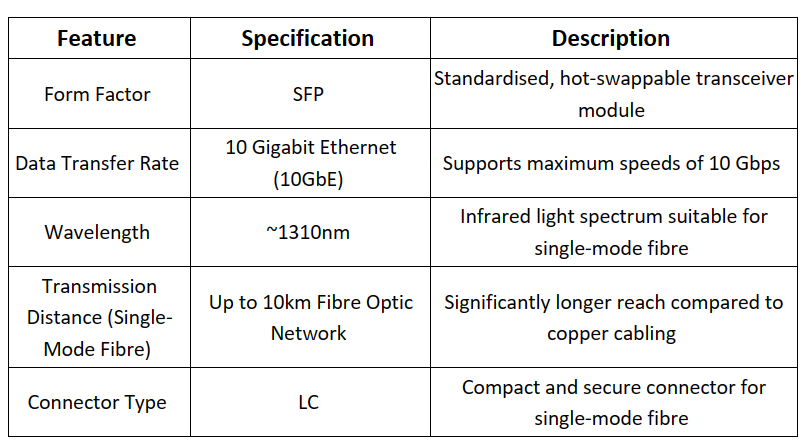
ARU-SFP-GE-LX: Powering Long-Reach 10 Gigabit Ethernet via Single-Mode Fibre
The ever-growing demand for data in today’s world is placing immense strain on network infrastructure. Businesses and organisations require high-bandwidth networks to support mission-critical applications, cloud computing, and the ever-increasing volume of data traffic.
10 Gigabit Ethernet (10GbE) technology has emerged as a vital solution for supporting these high-speed data transmission needs. However, traditional copper cabling solutions have limitations when it comes to long-distance deployments. This is where fibre optic technology shines, offering superior signal quality and reach over vast distances.
This blog explores the ARU-SFP-GE-LX SFP transceiver module, a key component in enabling robust and reliable 10GbE Single Mode SFP connectivity over single-mode fibre optic networks. We will delve into its technical specifications, applications, deployment considerations, and the advantages it offers for Long Distance Ethernet Connectivity.
Demystifying the ARU-SFP-GE-LX Transceiver

The ARU-SFP-GE-LX SFP transceiver module plays a vital role in enabling long-distance and high-bandwidth 10 Gigabit Ethernet (10GbE) connectivity over single mode fibre optics cable. Let’s delve deeper into its technical specifications and functionalities to understand its capabilities:
Form Factor: SFP (Small Form-factor Pluggable) is a standardised, hot-swappable transceiver module widely used in network switches, routers, and other networking equipment. This design allows for easy deployment and replacement of transceivers without interrupting ongoing network operations. Imagine SFP modules as Lego bricks for your network; they offer modularity and flexibility in configuring your switch or router’s connectivity options.
Data Transfer Rate: The ARU-SFP-GE-LX is specifically designed to support 10 Gigabit Ethernet (10GbE) data transfer rates. This translates to a maximum theoretical transmission speed of 10 billion bits per second (10 Gbps), a significant leap compared to traditional Gigabit Ethernet (GbE) with its 1 Gbps speed. This high-bandwidth capability caters to applications demanding the rapid transfer of large data files, video streams, and other bandwidth-intensive traffic.
Wavelength: Unlike copper cables that transmit electrical signals, fibre optic cables transmit data as light pulses. The ARU-SFP-GE-LX typically operates at a wavelength around 1310 nanometres (nm) – a specific range within the infrared light spectrum. This specific wavelength is well-suited for single-mode business fibre optic solutions, which have a smaller core diameter compared to multi-mode fibre. The smaller core size of single-mode fibre allows for a more focused light transmission with minimal signal distortion, enabling longer reach.
Transmission Distance: This is where the ARU-SFP-GE-LX truly shines. Compared to copper cabling limitations of just a few metres to around 100 metres for reliable 10GbE transmission, ARU-SFP-GE-LX boasts impressive reach of up to 10 kilometres (km) using single-mode fibre. This extended reach makes it ideal for connecting geographically dispersed locations within a campus, data centre backbones spanning large distances, or even metropolitan area networks (MANs) connecting businesses across a city.
Connector Type: The ARU-SFP-GE-LX typically utilises an LC connector, a common interface for single-mode fibre optic applications. The LC Connector SFP has a compact design with a square ferrule (the cylindrical end where the fibre core is housed) and a latch mechanism for secure connections.

In addition to these core specifications, the ARU-SFP-GE-LX module functions by performing a critical task: electrical-to-optical conversion. Incoming electrical data signals from the network device are converted into light pulses by the ARU-SFP-GE-LX’s internal laser source.
These light pulses travel through the single-mode fibre optic cable, and at the receiving end, the process is reversed. The ARU-SFP-GE-LX on the receiving side converts the light pulses back into electrical signals for the connected network device. This conversion process facilitates the transmission of data over long distances with minimal signal degradation, a key advantage of fibre optic technology.
Advantages of ARU-SFP-GE-LX over Copper Cabling
While traditional copper cabling has served as the backbone of network infrastructure for decades, ARU-SFP-GE-LX transceivers with single-mode fibre optic technology offer a multitude of advantages that make them a compelling choice for modern high-bandwidth applications. Let us delve deeper into these key benefits:
Superior Signal Quality and Reach
Copper cables are susceptible to signal degradation over distance. This is primarily due to factors like attenuation (weakening of signal strength) and crosstalk (electrical interference between cables). As cable lengths increase, signal quality deteriorates rapidly, limiting the effective reach of copper for high-speed data transmission.
In contrast, single-mode fibre optic cables experience minimal signal degradation over vast distances. ARU-SFP-GE-LX transceivers can reliably transmit and receive 10GbE data over impressive distances of up to 10km, making them ideal for long-distance deployments where copper cabling falls short.
Immunity to Electromagnetic and Radio Frequency Interference (EMI/RFI)
Copper cables are susceptible to electromagnetic and radio frequency interference from various sources like power lines, motors, and even radio waves. This interference can corrupt data signals, leading to errors and network instability. Fibre optic cables, on the other hand, are immune to EMI/RFI because they transmit light pulses instead of electrical signals.
This inherent immunity ensures reliable data transmission even in environments with high levels of electrical noise, a significant advantage for deployments in industrial settings, data centres with high concentrations of electronic equipment, or areas prone to external electromagnetic interference.
Security
Data security is a paramount concern in today’s digital world. Copper cables are susceptible to data tapping by intercepting the electrical signals transmitted through them. Fibre optic cables offer a significant security advantage. Because they transmit light pulses, it is extremely difficult to intercept and decode data travelling through a fibre optic cable without specialised equipment and physical access.
This inherent security makes ARU-SFP-GE-LX transceivers a valuable asset for applications where data confidentiality is critical, such as financial institutions, government agencies, and healthcare organisations.
Scalability and Future-Proofing
As data demands continue to grow, network infrastructure needs to be scalable to accommodate future bandwidth requirements. While copper cabling may suffice for current needs, its limitations in reach and signal quality can hinder future upgrades. ARU-SFP-GE-LX transceivers with single-mode fibre offer a future-proof solution.
The high bandwidth capacity of 10GbE and the extended reach of single-mode fibre provide ample headroom for supporting future network upgrades and bandwidth-intensive applications that may emerge.
Durability and Lower Maintenance Costs
Copper cables are susceptible to wear and tear over time, especially in harsh environments or with frequent movement. This can lead to cable damage and potential network disruptions. Single-mode fibre optic cables are significantly more durable and less prone to damage.
They are not susceptible to corrosion and are more resistant to physical stress. This translates to lower maintenance costs in the long run, as fibre optic cables require less frequent replacements compared to copper cables.
Space Efficiency
In high-density network environments like data centres, space is a valuable commodity. Copper cables tend to be bulky and require more space for cable management. Fibre optic cables, on the other hand, are thinner and lighter, allowing for more efficient use of space in crowded equipment racks. This space-saving advantage becomes increasingly important as data centre needs continue to evolve.
Applications for ARU-SFP-GE-LX Transceivers
The ARU-SFP-GE-LX transceiver proves valuable in various applications demanding high-bandwidth and long-distance Ethernet connectivity. Here are some prominent examples:
- Enterprise Data Centre Networks: Data centres require robust backbones to handle the high-speed data flow between servers and storage devices. ARU-SFP-GE-LX enables reliable 10GbE connections within the data centre, facilitating efficient data transfer and supporting demanding workloads.
- Long-Distance Campus Networks: Universities, corporate campuses, and other large organisations often require connections between buildings spread across vast areas. ARU-SFP-GE-LX bridges these distances with high-bandwidth 10GbE links, ensuring seamless network connectivity across the campus.
- Service Provider Networks: Service providers rely on high-performance networks to deliver bandwidth-intensive services to enterprise customers. ARU-SFP-GE-LX empowers them to establish reliable and long-distance connections, enabling them to cater to the growing data demands of their clients.
- Metropolitan Area Networks (MANs): MANs connect geographically dispersed locations within a city or metropolitan area. ARU-SFP-GE-LX facilitates the creation of high-bandwidth MANs, enabling efficient data exchange between businesses, government institutions, and other entities within the city.
- Fibre-to-the-Building (FTTB) Deployments: FTTB deployments aim to deliver high-speed internet access directly to residential and commercial buildings. ARU-SFP-GE-LX can play a crucial role in establishing the backbone infrastructure for these deployments, providing the necessary bandwidth and reach to connect individual buildings to the core network.
By utilising ARU-SFP-GE-LX transceivers, these applications can benefit from significant cost savings. Fibre optic infrastructure, while having a higher initial investment compared to copper, offers lower maintenance costs due to its superior durability and immunity to interference.
Additionally, the ability to transmit data over longer distances reduces the need for additional network equipment, further contributing to cost optimization.
Considerations for Deploying ARU-SFP-GE-LX

While ARU-SFP-GE-LX transceivers offer a compelling solution for long-distance 10 Gigabit Ethernet connectivity, careful planning and consideration of several factors are essential for successful deployment. Here’s a detailed breakdown of key aspects to keep in mind:
Compatibility:
Network Switch Compatibility: This is paramount. Ensure the chosen ARU-SFP-GE-LX module is compatible with the specific network switches being used. Consult the manufacturer’s documentation or compatibility lists to avoid compatibility issues that could disrupt network operations. Some vendors offer SFP transceivers with specific coding or programming that might only function with their own network equipment.
Network Design:
Fibre Optic Cable Selection: Meticulous planning is required for the fibre optic cable infrastructure. Key factors to consider include:
Cable Type: Single-mode fibre is necessary for ARU-SFP-GE-LX to achieve its maximum 10km Fibre Optic Network reach. However, within that category, there are different options like OS1 (optimised for long-distance) or OM1 (suitable for shorter distances). Choosing the right cable type depends on the specific application and desired reach.
Core Size: Core size impacts signal transmission characteristics. Smaller core sizes (like 9/125 microns) offer lower signal loss over longer distances but can be more challenging to work with during installation. Larger core sizes (like 50/125 microns) are easier to handle but may experience higher attenuation over extended distances.
Dispersion Characteristics: Different fibre optic cable types exhibit varying dispersion properties. For 10GbE applications, dispersion-shifted (DS) or non-zero dispersion-shifted (NZ-DS) fibres are preferred to minimise signal distortion over long distances.
Cable Length Planning: Consider the maximum reach capabilities of ARU-SFP-GE-LX (typically 10km) and factor in any additional cable slack required for equipment movement or future expansion. Avoid exceeding the recommended cable length limitations to ensure optimal signal strength.
Connection Points: Strategically plan the placement of connection points (patch panels, splice enclosures) to facilitate cable management and future maintenance needs.
Installation:
Importance of Proper Practices: Fibre optic cable installation requires specialised tools and techniques to ensure clean and secure connections. Dust, even microscopic particles, can significantly impact signal quality. Consider consulting with certified fibre optic installers for a professional and reliable installation.
Cable Handling: Fibre optic cables are delicate and require careful handling to avoid damage. Bending them beyond the minimum bend radius can cause permanent signal degradation. Follow recommended bend radius specifications for the specific cable type being used.
Connector Cleaning: Maintain a clean work environment during installation and always use dust caps to protect cable ends when not in use. Regularly inspect and clean connectors with lint-free wipes and appropriate cleaning solutions to prevent dust buildup that could hinder signal transmission.
Maintenance:
Inspection and Cleaning Schedule: Implement a preventive maintenance schedule for regular inspection and cleaning of fibre optic cables and connectors. This helps to identify potential issues like dust accumulation or cable damage early on, preventing them from impacting network performance.
Monitoring Capabilities: Some ARU-SFP-GE-LX transceivers may support Digital Diagnostics Monitoring (DDM) functionality. DDM allows real-time monitoring of operational parameters like temperature, laser bias current, and optical power output. This information is valuable for network administrators in identifying potential problems and ensuring optimal performance.
Additional Considerations:
Power Consumption: While generally low power compared to some other transceiver types, the power consumption of ARU-SFP-GE-LX modules can vary depending on the specific model and vendor. Consider the power requirements of your network switches and ensure they can adequately supply power to the transceivers.
Environmental Conditions: Temperature and humidity can impact the performance of ARU-SFP-GE-LX transceivers. Ensure the operating environment meets the manufacturer’s specifications for temperature and humidity range.
Regulations: Depending on your location and application, there may be specific regulations or standards that need to be considered when deploying fibre optic cabling and transceivers. Consulting with a qualified network engineer or IT professional can help ensure compliance with relevant regulations.
Conclusion
In conclusion, the ARU-SFP-GE-LX transceiver offers a reliable and cost-effective solution for conquering long-distance Ethernet connectivity challenges. Its exceptional reach, immunity to interference, and support for 10 Gigabit Ethernet make it ideal for data centres, campuses, and various demanding applications.
For businesses and organisations seeking to leverage the power of ARU-SFP-GE-LX to enhance their network infrastructure, Megnet is your trusted partner. We offer a comprehensive selection of high-quality ARU-SFP-GE-LX transceivers, exceptional customer service, and competitive pricing. Visit Megnet today to explore our product offerings and discover how ARU-SFP-GE-LX can revolutionise your long-distance Ethernet connectivity.

FAQ's
Yes, their long-reach capabilities make them perfect for creating reliable 10GbE links between buildings on expansive campuses.
Undoubtedly. They can leverage ARU-SFP-GE-LX to establish long-distance connections and cater to the growing data demands of their enterprise clients.
Yes, they can play a crucial role in establishing the backbone infrastructure for FTTB deployments, providing the necessary bandwidth and reach to connect individual buildings to the core network.
Selecting the appropriate single-mode fibre optic cable type depends on factors like core size and dispersion characteristics. Consulting a network specialist is recommended.
While possible, proper installation techniques are essential for optimal signal integrity. Consider using certified fibre optic installers for a professional job.
As technologies like cloud computing, AI, and IoT gain traction, the need for high-bandwidth connections will increase. ARU-SFP-GE-LX can provide the foundation for these advancements by enabling efficient data transfer.
While designed for 10GbE, some newer SFP transceiver models built on advancements in laser technology might support future higher data rates over single-mode fibre.
As fibre optic technology matures and manufacturing processes improve, the cost of ARU-SFP-GE-LX transceivers and cabling is likely to become more affordable over time.
Generally yes, provided they adhere to the SFP Multi-Source Agreement (MSA) ensuring interoperability. However, always consult your Ethernet switch transceiver documentation for confirmed compatible SFP models.
The SFP MSA is an industry standard that defines the electrical, mechanical, and optical specifications for SFP transceivers. It guarantees compatibility between SFP modules from different vendors when used with compliant network devices.







Leave a comment
Your email address will not be published. Required fields are marked *